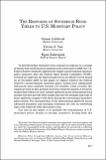Artículo
The response of sovereign bonds yields to U.S. monetary policy
Date
2016Abstract
To provide further stimulus to the economy in response to a cascade of shocks that roiled financial markets in the latter part of 2008 the U.S. Federal Reserve started to aggressively employ unconventional monetary policy measures after the Federal Open Market Committee (FOMC) lowered the target for the federal funds rate to its effective lower bound on 16 December 2008. In this paper we explore whether the Federal Reserve’s unconventional monetary policy actions have significantly influenced asset markets beyond U.S. borders. Until recently the empirical work on this question has been relatively limited. A few prior studies find evidence of cross-country spillovers in the international bond market but they provide little insight into how the strength and scope of these spillovers compare with those during the conventional monetary policy period. The characteristics of the international spillovers across advanced economies and emerging economies are also an interesting topic with relatively little discussion so far.
Collections
View/


